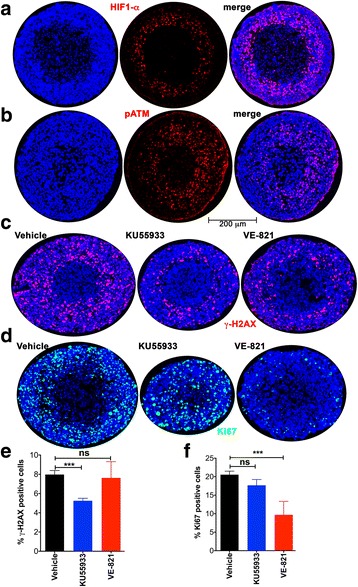Fig. 5.

ATM activation is linked to γ-H2AX formation while ATR activity contributes to proliferation in A673 spheroids. a Activation of the hypoxia-responsive factor HIF1-α (red with blue Hoechst 33,342 counter-stain) is observed in the peri-necrotic zone of A673 spheroids 570–650 μm in diameter. b Activation of ATM (phosphorylation at serine 1981 (pATM); red with blue Hoechst 33,342 counter-stain) is seen in the hypoxic, peri-necrotic zone. c The distribution of γ-H2AX (red, with blue Hoechst 33,342 counter-stain) in spheroids maintained for 96 h in either vehicle, the ATM inhibitor KU55933, or the ATR inhibitor VE-821. Spheroids were <500 μm in diameter at the start of the experiment and vehicle-treated spheroids were approximately 700 μm in diameter at the end of 96 h. Both KU55933 and VE-821 impaired spheroid growth. d The distribution of Ki-67 (green, with blue Hoechst 33,342 counter-stain) in spheroids maintained for 96 h in either vehicle, the ATM inhibitor KU55933, or the ATR inhibitor VE-821. e Bar graph showing percentage of γ-H2AX-positive cells per spheroid when maintained for 96 h in either vehicle, the ATM inhibitor KU55933, or the ATR inhibitor VE-821. Mean and standard deviation are shown; each bar represents at least 15 spheroids from three independent experiments. f Percentage of Ki-67-positive cells per spheroid when maintained for 96 h in either vehicle, the ATM inhibitor KU55933, or the ATR inhibitor VE-821 is shown as the mean and standard deviation; each bar represents at least 15 spheroids from three independent experiments. One way ANOVA with Dunnett’s post-test. ***P < .001, ns P > .05
